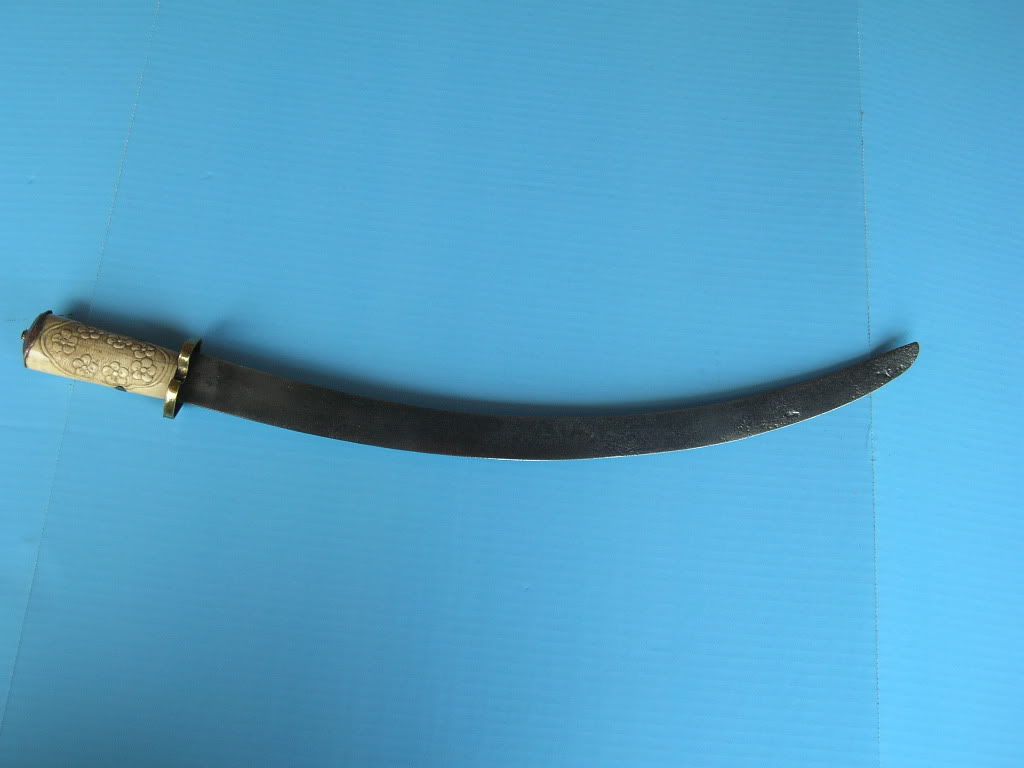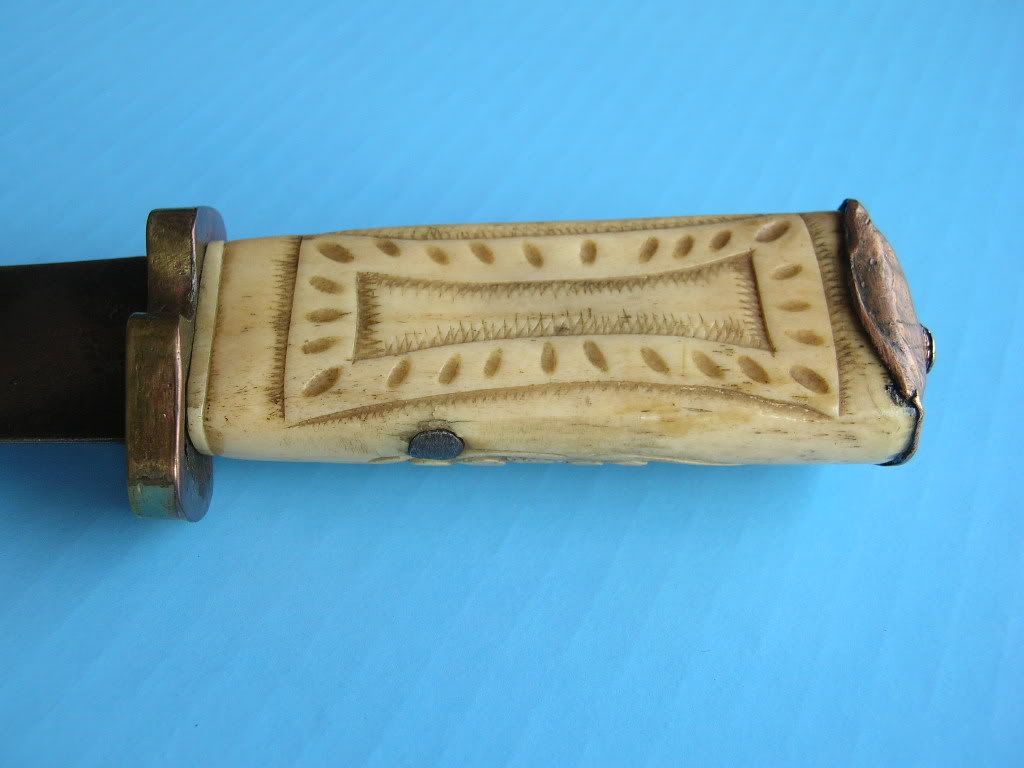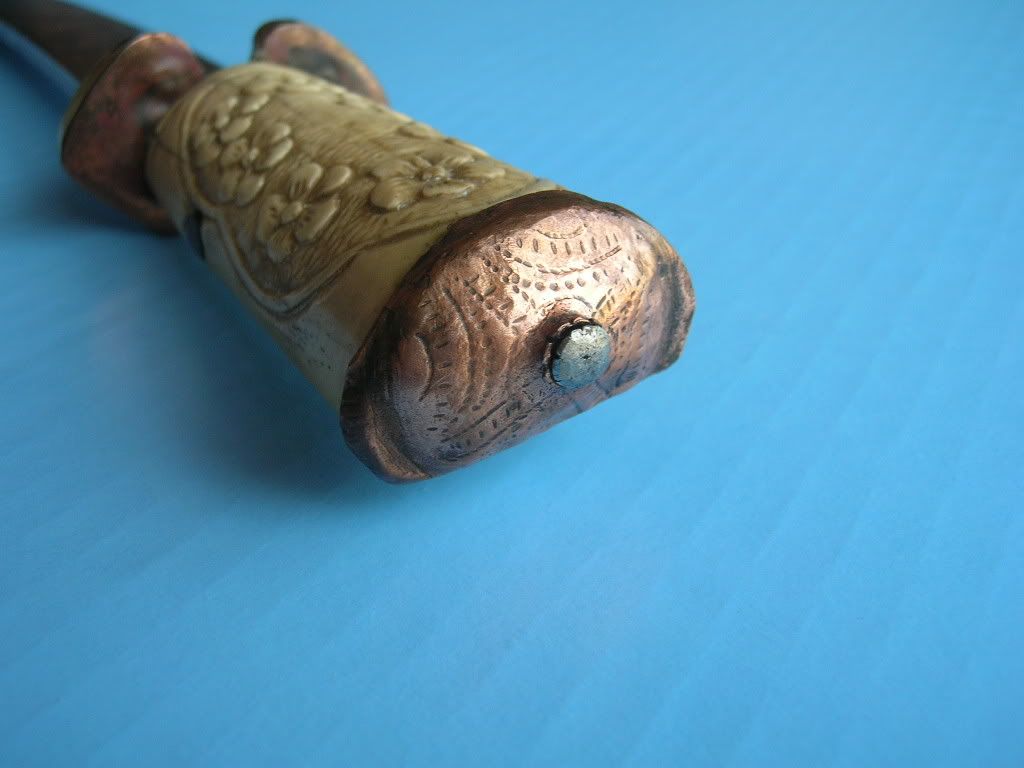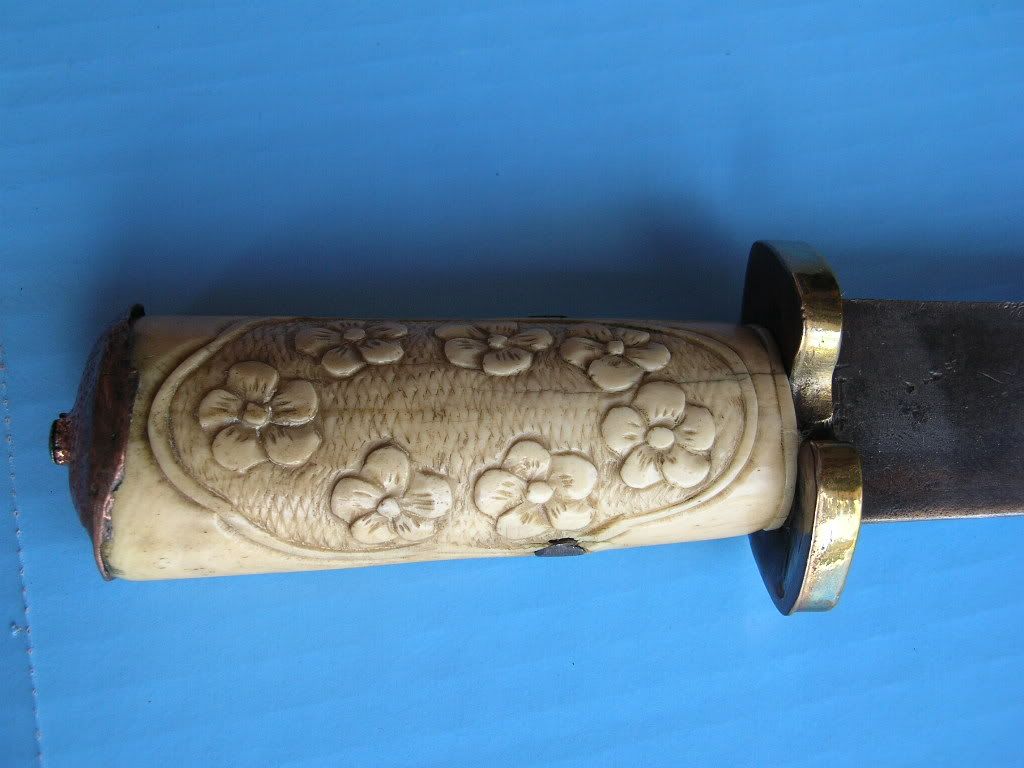
 |
|
|
|
|
#1 |
|
Member
Join Date: Dec 2004
Location: NC, U.S.A.
Posts: 2,097
|
http://cgi.ebay.com/ws/eBayISAPI.dll...MEWA%3AIT&rd=1
Ignore this link! Last edited by M ELEY; 3rd June 2005 at 03:24 AM. Reason: Bad link |
|
|

|
|
|
#2 |
|
Member
Join Date: Dec 2004
Location: NC, U.S.A.
Posts: 2,097
|
Oh well...couldn't get it to pull up that way. I just won this sword and was seeking the opinions of the folks here. It's eBay item # 653366647. I just received it in the mail and am curious as to its origin. In my own opinion, I think this could be American, post-Rev War. It is similar in pattern to the so-called "figure 8" hilted swords of the 1780-1810 period. Its corrigated hilt indicates post 1800 date. It is similar to the British M1845 patterns, but I'm convinced it predates them. Its blade is only sharp at the end, is strangely/sharply curved, making it different from most British patterns, and has a wedge-shaped non-fullered blade. The hilt is not the typical patterns of anything I've seen. You'll note that the blade was strengthened by a brazing of brass where the blade and cup-guard meet. This brass has patina to it, indicating that the sword was either originally made this way, or its an old repair during its working life. My question is, did American naval swords of the Federalist period/war of 1812 have swords like this? Could this be colonial Spain? The brazing-is this seen on American swords of this period. I've seen ones in Neumann's that were strengthened with lead. I know many naval swords of this period were "private purchase", but as I understand it, didn't most British/European swords of this period still follow a typical pattern unlike this? This would have definately been non-regulation. Did most naval swords of this period have unfullered blades, or is this more of a tendency of American/colonial swords? Thanks all!
|
|
|

|
|
|
#3 |
|
Member
Join Date: Dec 2004
Location: B.C. Canada
Posts: 473
|
Is there any way you can post the pictures, I am unable to get any using your links.
Jeff |
|
|

|
|
|
#4 |
|
Member
Join Date: Dec 2004
Location: NC, U.S.A.
Posts: 2,097
|
Let's try this again, as the first link was bad...
http://cgi.ebay.com/ws/eBayISAPI.dll...tem=6533666477 |
|
|

|
|
|
#5 |
|
Member
Join Date: Nov 2004
Location: USA
Posts: 1,725
|
Boy, that blade really does remind me of the sword we discussed on this old thread: http://www.vikingsword.com/ubb/Forum1/HTML/001880.html
The pix are long gone. I'll try to take some tomorrow and post them here for comparison. By the way, it's good to see you posting, Mark. Welcome back. 
|
|
|

|
|
|
#6 |
|
Member
Join Date: Dec 2004
Location: NC, U.S.A.
Posts: 2,097
|
Thanks, Andrew! I still visit the site frequently (with all of this information from such esteemed sources, it would be foolish not to), but don't have much free time to post. Yes, I do remember this particular sword with its sharply curved blade. Well, thats one that didn't occur to me! There is a distinct possibility that this could be a Chinese cutlass. Still, if it weren't for the blade, I'd still assume British or American merchantman. Would like to see pics of that old sword we discussed again, though, for comparison.
|
|
|

|
|
|
#7 |
|
Member
Join Date: Nov 2004
Location: USA
Posts: 1,725
|
Mark, we finally got some clear weather yesterday, and I took some shots of my sword. I noticed something interesting at the forte, but will start a new thread about that so as not to hijack yours.
    
|
|
|

|
|
|
#8 |
|
Member
Join Date: Dec 2004
Location: Houston, TX, USA
Posts: 1,254
|
That edgewise pin is fairly interesting, too; you didn't really tell us about that before, I think?
Those ebay pics are deceptive; it really looks like a swelled tip. Is the hilt all-metal? What metal? Is it one piece? The hole in the bowl amost looks as if it goes right to the edge of the blade or even of the tang? Commentary? Explanation? Possible driver of the brazing? The way the brass is puffed up so far above the joint suggests it was dropped on/in, whether from a ladel, or a rod; not placed solid then melted in place after the nature of traditional brazing. BTW, I don't neccessarily think it is one (though with the tip not being swelled....), but the wedge section is not unseen on European swords. It is in fact sometimes seen, most notably on hangers. |
|
|

|
|
|
#9 |
|
Member
Join Date: Dec 2004
Location: NC, U.S.A.
Posts: 2,097
|
Andrew, you are right about the similarity in the blades, especially with the pitting (I wonder if yours might not have seen sea service to be pitted in this way- salt air and all. I still believe that mine has a European blade, though...
|
|
|

|
|
|
#10 |
|
Member
Join Date: Dec 2004
Location: NC, U.S.A.
Posts: 2,097
|
Tom, sorry to take so long to get back to this thread. I've been doing research via Gilkerson's book "Borders Away" and Annis' "Naval Swords" and I'm still convinced that my sword is the real deal- that is, a private purchase cutlass for a merchantman ship, possibly ca 1800-20. These swords came in all shapes,sizes. Many were crude, having been repaired in the field, refitted, resharpened, painted with pitch, etc.
Now-about the sword. The iron grip fits the patterns of 1800-20, the rouned dish guard is cruder than the ebay pic lets on (i.e. I doubt its machine-made). The diamond-cut to the hilt does go right uo to the blade edge. The whole hilt construction is odd/unique, as most of these had a separate grip with piened tang where the sheet guard comes into it. This hilt appears to be constructed as a whole, with the grip/guard/bowl all as one piece (the only other possibility is that it,too, is welded with brass, but if it is, it is lost under many layers of old marine pitch/paint of the era). If this is the construction of the hilt(whole), then I suppose that the blade might have been slid in place and brazed with brass to hold it firm. I believe that the blade is European and of the period. Interesting items, these private purchase sea swords...kind of ethnogrphic in their variety! |
|
|

|
|
|
#11 |
|
Member
Join Date: Dec 2004
Location: NC, U.S.A.
Posts: 2,097
|
Tom, I know you know much about construction and smithing of weapons. It does appear that the hilt on this sea sword was slid into a constructed hilt and then brass poured into the socket to secure it. Have you ever heard of this process being done? Time period and/or country of origin? Just read in Annis' book that many sea swords were made from brass, as it doesn't corrode nearly as fast as traditional iron does (the reason so many naval swords were painted with pitch- glad they chose black paint BTW. Can you imagine if some joker decided on pink!), so perhaps that's why this is the reasoning behind the construction of the joint...
|
|
|

|
 |
|
|